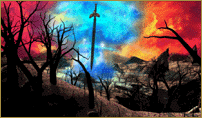

Water.
Water is an additional factor in some maps that must be discussed separately. If
there is a lot of water on the map, then start exploring it very soon. (possibly even on
day 2 or so) Sometimes crossing a body of water is the only way to reach certain
regions of the map. Always be wary of invasions when your town lies close to the
coast. Clear the 'Fog of War' from the ocean close to your town, and be sure to check
out the exitpoints of nearby whirlpools to limit the possibility of surprise raids. Keep
in mind that a hero's movement ends when he/she embarks or disembarks. You can
use boats to arrange surprise attacks yourself by stealing towns and mines when the
enemy is away.
Subterranean Levels.
Maps with a Subterranean level are larger and more complex. Though the existence
of subterranean gates is something you should consider, (don't wait to explore them
till an enemy hero comes through to surprise you) but the true impact on the gameplay
is not extremely large. They just make maps twice as big and thereby extend the time
you need to complete the map a lot.
The Grail.
Throughout the map you can often see the obelisks that reveal parts of the Puzzle
Map. Usually it is not such a wise idea to send out some heroes to go find all the
obelisks to be able to uncover the Grail. In larger maps or if you are playing in a team,
you can be fast enough to see almost the entire Puzzle Map before the Grail is
actually found. When you almost know its position and if you can spare the money
do as follows: recruit as many heroes as you can and start digging like hell on spots
where the Grail might be. When you eventually find it, carry it to the town of your
choice and build the Grail-structure. What the Grail does will be discussed separately
in the Per Town Strategy.
Wandering Creatures. (population labels)
Wandering creatures are not allied to any player and don't move around on the map.
The Visions spell reveals their mood (if they are hostile or willing to join) and the
number of creatures in the stack. When you don't use this spell, you only get to see a
rough estimation of the amount of creatures. The following list explains the labels:
Label | Few | Several | Pack |
Lots | Horde | Throng | Swarm |
Zounds | Legion |
|---|
Population | 1-4 | 5-9 | 10-19 |
20-49 | 50-99 | 100-249 | 250-499 |
500-999 | 1000+ |
|---|
Movement Allowance.
How far a hero can move is determined by the speed of the slowest creature in his/her
army. It is always smart to leave slow creatures behind to defend your town with.
(when you can afford the loss of combat-power in your army by leaving them behind)
When one of your (minor) heroes is being chased by enemy heroes, it might also be a
good thing to dismiss the slowest creatures in his/her army to get a faster movement
and escape from a certain death. As the distances on the map are measured in tiles,
the next table shows all existing cases of movement allowance:
Slowest creature speed tag | Super Slow-Extra Slow |
Slow | Swift-Extra Swift | Very Swift |
Ultra Swift-Super Swift | Quick-Super Fast |
|---|
Slowest creature speed | 3-4 | 5 | 6-7 | 8 |
9-10 | 11-MAX |
|---|
Movement allowance | 15 tiles |
16 tiles | 17 tiles | 18 tiles |
19 tiles | 20 tiles |
|---|
Terrain Movement Costs.
Some terrain types have movement penalties and roads allow faster movement. The
secondary skill Pathfinding eliminates the movement penalty by 25% per level (Basic,
Advanced and Expert) until they are at 100%. The list below shows the movement
penalties for a hero without Pathfinding (larger numbers mean that more movement-
points are consumed) :
Terrain type | Cobblestone Road | Gravel Road |
Dirt Road | Dirt | Grass |
Lava | Rough | Sand | Snow |
Swamp |
|---|
Movement penalty | 50% | 65% |
75% | 100% | 100% |
100% | 125% | 150% | 150% |
175% |
|---|
Effects Of Native Terrain.
Heroes with armies composed entirely of creatures native to the same terrain suffer no
movement penalty when travelling over that terrain. Also, all units get a +1 speed
bonus during combat when they are fighting on native terrain. The table below names
the specific type of 'homeground' or native terrain for every town:
Town type | Castle | Conflux |
Dungeon | Fortress | Inferno |
Necropolis | Rampart | Stronghold |
Tower |
|---|
Terrain type | Grass | Grass |
Subterranean | Swamp | Lava |
Dirt | Grass | Rough |
Snow |
|---|